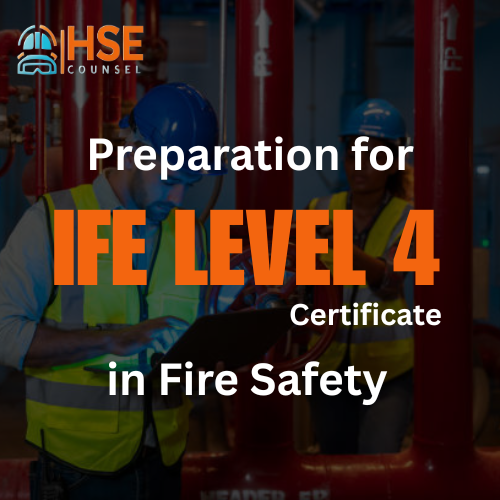Curriculum
- 7 Sections
- 105 Lessons
- 65 Weeks
Expand all sectionsCollapse all sections
- Understanding IFE Level 4 Certificate in Fire Safety1
- Fire Safety and Fire Engineering Principles21
- 2.1Passive Fire Safety
- 2.2Active Fire Safety
- 2.3Pressurisation
- 2.4Leakage Paths
- 2.5Automatic Suppression Systems
- 2.6Smoke Control and Air Handling
- 2.7Compartmentation
- 2.8Fire Detection and Warning Systems
- 2.9Design Fire Size
- 2.10Smoke Movement
- 2.11ASET/RSET and factors that affect different phases of evacuation
- 2.12Fire Resistance
- 2.13Fire Load
- 2.14Fire Growth
- 2.15Limit of Tenability
- 2.16t² Growth Rate
- 2.17Zone and Fire Models
- 2.18Use of flow chart to support design process
- 2.19Fire/Smoke modelling, examples of programmes
- 2.20Pedestrian flow/evacuation modelling
- 2.21Quiz 1 – Fire Safety and Fire Engineering Principles5 Questions
- Human Behaviour in Emergency Situations10
- 3.1Interaction between Fire safety systems and Human behaviour
- 3.2The physiological, behavioural and psychological effects on people confronted by a fire situation
- 3.3How behaviour of people in a fire can adversely affect evacuation and means of escape
- 3.4Emergency procedures for the safe evacuation of people from a fire situation
- 3.5Individuals with particular requirements to include the young, the old, the disabled, those with poor health, short term and long-term conditions, cognitive impairment and people from different cultures
- 3.6Behavioural aspects of people in fire and implications when planning/reviewing means of escape and evacuation procedures
- 3.7Major incidents of Note
- 3.8Identification of patterns and application of learning from previous incidents
- 3.9Case Study – Grenfell Tower
- 3.10Quiz 2 – Human Behaviour in Emergency Situations5 Questions
- Fire Protection Equipment18
- 4.1Types of System
- 4.2Success or Failure of Operation
- 4.3Automatic Fire Detectors – Radio Systems
- 4.4Automatic Fire Detection – Detector Circuits
- 4.5Zones, addressable for complex evacuation strategies, double knock, multi-purpose detectors
- 4.6Aspirating systems
- 4.7Control and Indicating Equipment
- 4.8Sprinkler systems: Commercial, Residential, and Domestic (life safety)
- 4.9Other water- based systems, drenchers, foam, water mist
- 4.10Gaseous Systems
- 4.11Oxygen Depletion Systems
- 4.12Explosion Detection Systems
- 4.13Explosion Venting Systems
- 4.14Explosion Suppression Systems
- 4.15Control of Flammable Atmospheres
- 4.16Fire Curtains
- 4.17Shutters
- 4.18Quiz 3 – Fire Protection Equipment5 Questions
- Building Design37
- 5.1Evaluate plans to identify risk and provide fire safety solutions
- 5.2Applied Protection
- 5.3Modern Methods of Construction
- 5.4Cross Laminated Timber
- 5.5Steel Frame
- 5.6Glulam
- 5.7Large structural timber
- 5.8Structural Insulated Panels
- 5.9Modular Construction
- 5.10Fire retardant, Intumescent treatments
- 5.11Upgrading fire resisting doors
- 5.12Atria
- 5.13Glazing
- 5.14Separating Walls
- 5.15Compartment Walls and Floors
- 5.16Junctions Formed by Elements of Structure
- 5.17Protected Shafts and Protecting Structures
- 5.18Fire Resisting Doors and Other Enclosures
- 5.19Claddings
- 5.20Facades
- 5.21Tunnels
- 5.22Heating Systems
- 5.23Ventilation
- 5.24Air Conditioning Systems
- 5.25Stairwell Pressurisation Systems
- 5.26Ventilation and Smoke Handling Systems
- 5.27Lifts/Elevators
- 5.28Escalators
- 5.29Travellators
- 5.30Consultation Process
- 5.31Qualitative Design Review (QDR)
- 5.32Interaction and Compatibility Between Different Materials
- 5.33Unexpected consequences of Inappropriate Selection, Use, Location, Orientation and Interaction of Materials
- 5.34Impact of Quality of Construction
- 5.35Impact of Modern Methods of Construction
- 5.36During Construction and Alterations
- 5.37Quiz 4 – Building Design5 Questions
- Fire Safety Management, Review and Advice22
- 6.1Principles and methods of risk assessment in Complex premises and Environments
- 6.2Impact of structure, materials and access
- 6.3Identification of people who may be at risk
- 6.4Identification of risks to Property and the Environment
- 6.5How to explain risks to Members of the Public and Property owners/managers
- 6.6Common causes of Fire in Different Occupancies
- 6.7How to Review Effectiveness of Current Measures
- 6.8How to provide Feedback on Effectiveness of Current measures
- 6.9Impact of Organisational Constraints
- 6.10Strategic thinking
- 6.11The Use of Fire Statistics to Inform Decisions on Fire Safety Programmes
- 6.12Risks in the Community and Prioritising Fire Safety Programmes
- 6.13Objectives of Fire Safety Education in the Community
- 6.14Contents of Fire Safety Programmes and their Purpose
- 6.15Methods to Engage Diverse Community Members and Stakeholders
- 6.16Methods to Evaluate Success of Programmes
- 6.17Strategic Thinking
- 6.18Level of Fire Safety Knowledge and Responsibility at Different parts of the Organisation
- 6.19Engaging and Training Employees in Different Premises/Workplaces and in Different roles
- 6.20Identification of Training Requirements for People with Fire Safety Responsibility
- 6.21Importance of Testing and Reviewing Precautions in Place and how to do this
- 6.22Quiz 5 – Fire Safety Management, Review and Advice5 Questions
- Preparing & Booking for Exams1



